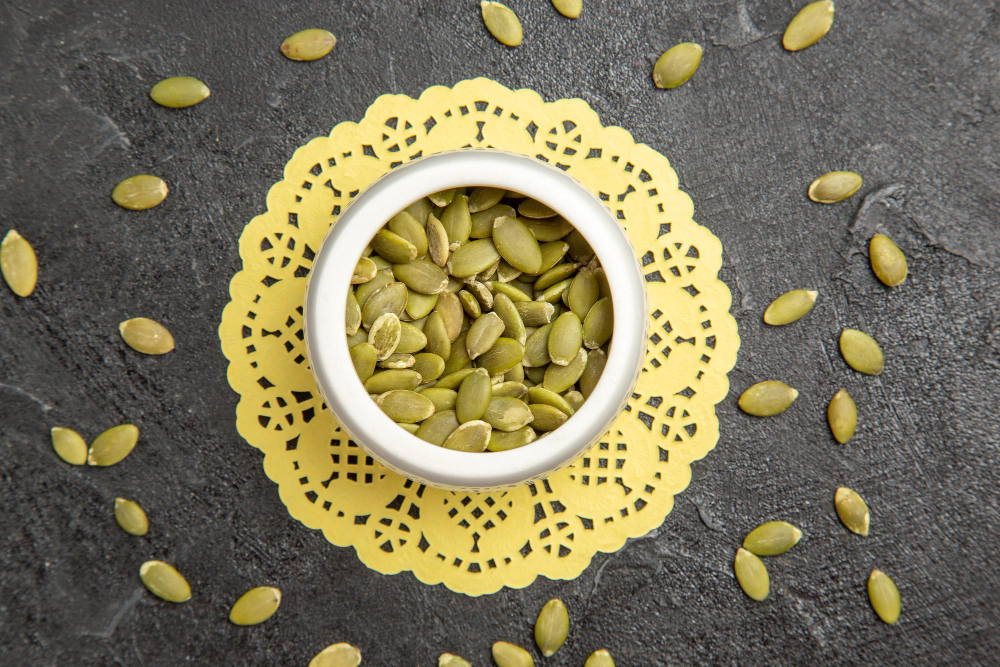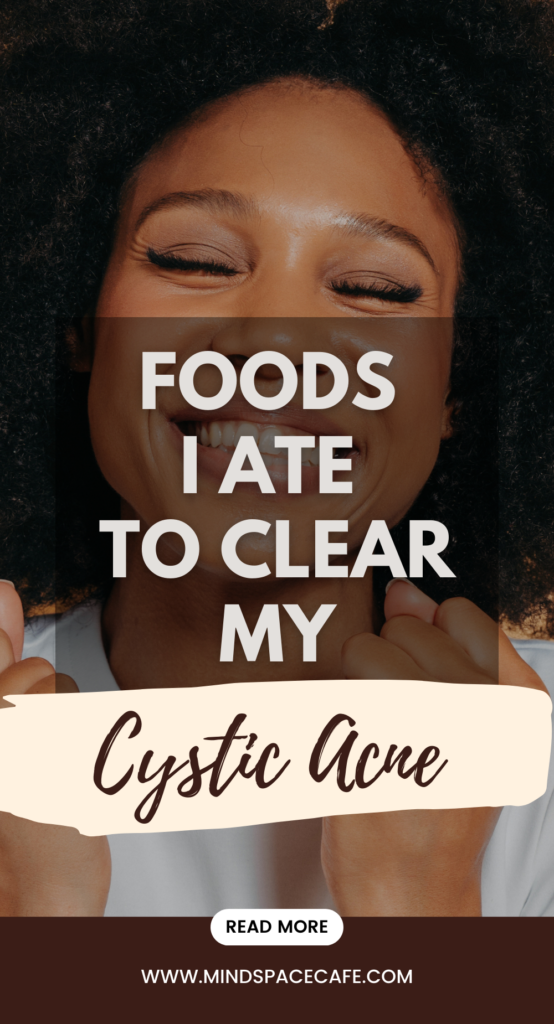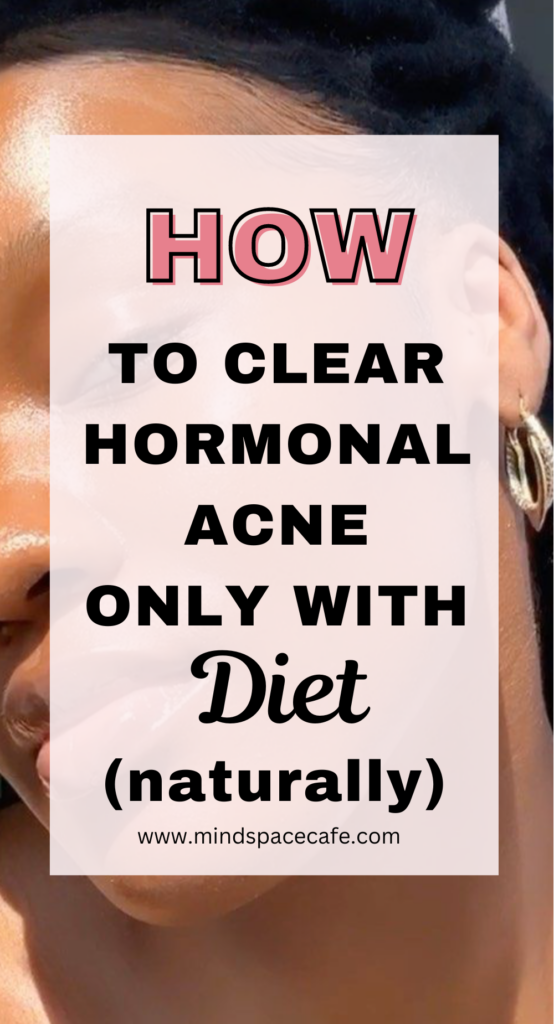First off, I need you to know that I have been suffering with acne for over 20 years.
Initially, I assumed it was only going to last my teenage years and I’d be rid of it by the time I was in my 20s.
It did get milder in my 20s and returned in full swing in my my late twenties.
I started developing painful cystic and hormonal acne.
I’ve been to many dermatologists and they were genuinely not able to get to the root of the problem – they’ll usually prescribe antibiotics or try to force you to do Accutane.
Both did a number on me.
This year I was determined to get to the root of the problem.
I was able to clear my acne in less than 10 weeks, and I’m linking to the post that helped me do it.

I still get chin acne during my periods but it’s manageable.
In this post, I want to dive into the foods I particularly ate to help me solve my hormonal acne.
I know a lot of people don’t go into their hormonal acne diet because it’s not fancy but this is how you treat cystic acne and get to the root cause.
Because diet is one of the main ways you clear acne.
It actually works.
PLEASE READ: A few things to note:
- Please read this post for everything I did to clear my acne.
- Please read this post on quotes about acne that will make you feel better about your skin if you’re struggling with confidence and self-esteem like I do.
- I maintained a food diary for 2 years to understand what foods agreed with me and what didn’t.
- I started eating a lot of greens and cruciferous veggies, I’ll get into that in this post
- I will cover what worked for me, and also go about what didn’t.
This is a heavy post.
Now, without further ado, let’s dive in!
This post contains affiliate links, meaning I may make a commission at no extra cost to you if you decide to click on a link and purchase something. Click here to read the full disclaimer.
Why does acne depend so much on diet?
I know acne sucks; believe me, I do.
I get it, some people can eat anything and everything and nothing happens to them.
I have a friend who drinks a lot of alcohol, eats a ton of junk food, and has glass skin.
Her brother who eats the same diet she does has severe cystic acne like me.
Don’t get me started on “Life is unfair.”
I understand.
Here’s the thing though.
Acne is influenced so much by diet because our bodies don’t handle certain foods well.
Certain foods can trigger hormonal changes, inflammation, and the production of sebum (skin oil), all of which play a role in acne formation.
Sometimes, diets high in refined carbs, sugar, and dairy products can increase insulin levels and insulin-like growth factor1 (IGF-1), which also leads to increased oil production and skin cell turnover, creating an environment where acne-causing bacteria thrive.
For some people, it’s processed foods or those high in healthy fats that can worsen acne by triggering inflammatory responses in the skin.
This is why eating certain foods helps – they’re called anti-inflammatory foods.
These foods can balance hormones and reduce inflammation, improving skin health.
Start adding these foods slowly in your diet.
You don’t need to do it all in one day.
For instance, try having spearmint tea everyday first, then slowly add chia seeds to your breakfast after a week or two.
The idea is to form a habit so that your body gets used to these foods and you learn to like it.
Get my drift?
Let’s get into this.
1. Omega-3 Rich foods

Omega-3 fatty acids are powerful anti-inflammatory agents that can reduce the inflammation often associated with acne.
They help balance the skin’s oil production and prevent clogged pores, which can lead to breakouts.
Here’s how omega-3 foods help:
- Flaxseeds: Flaxseeds are one of the richest plant-based sources of omega-3s, specifically ALA (alpha-linolenic acid). You can add ground flaxseeds to smoothies, oatmeal, or baked goods for a nutritional boost.
- Chia Seeds: Like flaxseeds, chia seeds are packed with ALA omega-3s. They can be added to smoothies, yogurt, or used in chia puddings for a healthy dose of omega-3.
- Hemp Seeds: Hemp seeds provide a good amount of ALA, as well as other healthy fats and protein. They’re great in salads, smoothies, or sprinkled on toast.
- Walnuts: Walnuts are an excellent plant-based source of omega-3s. You can snack on them raw, add them to salads, or use them in baked goods for a crunchy and nutritious addition.
- Algal Oil: Derived from algae, algal oil is a vegan-friendly source of EPA and DHA (the two forms of omega-3 typically found in fish). It can be taken as a supplement and provides a direct source of these important fatty acids.
- Brussels Sprouts: While not as concentrated as seeds and nuts, Brussels sprouts contain a notable amount of ALA and are rich in fiber and vitamins. They make a great addition to any plant-based diet.
- Effect on Hormones: Omega-3s also help regulate hormone levels, particularly insulin and androgens, which can affect sebum production and, in turn, acne development.
2. Fruits and vegetables

Fruits and vegetables are full of antioxidants, vitamins, and fiber, which actually help your body maintain a healthy balance.
As much as these words are overused, they’re actually helpful: Eat the rainbow.
I know it’s suddenly difficult to consume so much fruits and veggies but again, do it slowly.
Try adding a handful of veggies to your lunch first and slowly have that everyday.
Once you’re used to that, eat a bowl of cut fruit sometime during the day when you feel like snacking on cookies/chips.
Making this switch is painful.
But in order for you to reap the benefits of beautiful skin, you have to make these sacrifices in the beginning.
I say beginning because your body will soon love the fruits and veggies and your palate will get used to it – you’ll start craving it – no joke.
So, here’s how they help:
Effect on Detoxification: Vegetables like broccoli, Brussels sprouts, and cauliflower contain compounds that support liver detoxification. If you help your liver detoxify, it will send less junk to your skin and you will have better skin – trust me.
Leafy Greens (Spinach, Kale, Swiss Chard): Dark leafy greens are rich in vitamins A, C, and K, as well as antioxidants. Vitamin A, in particular, helps regulate skin cell production, preventing the buildup of dead skin cells that can clog pores. Vitamin C helps in collagen production, promoting skin repair and reducing post-acne scarring.
Berries (Blueberries, Strawberries, Raspberries): Berries are packed with antioxidants like vitamin C and polyphenols, which combat free radicals—unstable molecules that can damage skin cells and lead to inflammation. By neutralizing these free radicals, berries help reduce skin irritation and promote a more even skin tone. Throw them in your greek yogurt or pop them in your mouth as a healthy snack.
Colorful Vegetables (Carrots, Sweet Potatoes, Bell Peppers): These vegetables are rich in beta-carotene (a precursor to vitamin A) and other carotenoids, which protect skin from inflammation and oxidative stress. Beta-carotene helps in normalizing skin cell turnover, reducing the risk of clogged pores and blemishes. I like to stir-fry these veggies with a little olive oil, salt, and pepper and add them to my lunch.
3. Zinc-rich foods

Zinc does 2 things: It regulates oil production and supports the immune system – both of which help with acne.
- Pumpkin Seeds: One of the best plant-based sources of zinc. You can snack on them raw, roast them, or add them to salads and yogurt.
- Chickpeas: Chickpeas, and other legumes like lentils and beans, are a good source of zinc. You can make hummus or make a chickpea curry which I can eat day and night.
- Hemp Seeds: In addition to being high in omega-3s, hemp seeds are also rich in zinc. Add them to smoothies, or yogurt, or sprinkle them on top of salads.
- Cashews: Cashews are another excellent source of zinc. You can eat them as a snack, add them to stir-fries, or use cashew butter as a spread. If nuts trigger your acne, avoid this.
- Quinoa: Quinoa is a complete protein and contains zinc. Use it as a base for salads or as a side dish to boost zinc intake.
- Fortified Cereals: Many breakfast cereals and whole grains are fortified with zinc. Please check the label to ensure you’re getting a good source of the mineral.
- Tofu and Tempeh: Both tofu and tempeh, made from soybeans, are good sources of zinc and can be used in a variety of dishes like stir-fries, salads, or as a meat substitute. Please check if soy agrees with you – for me it triggers my acne so I don’t consume anything with soy.
- Oats: Oats are not only a healthy grain but also contain zinc. You can enjoy them as oatmeal, in smoothies, or as part of baked goods.
- Mushrooms: Some varieties of mushrooms, particularly shiitake, contain zinc and make a great addition to vegetarian meals.
By eating these foods, you support your skin’s ability to heal, regulate oil production, and fight inflammation, helping reduce the frequency and severity of acne breakouts.
I understand that some foods (which are supposed to help with acne) can trigger acne as well. That’s why you need to maintain a food diary.
Maintaining a food diary will help you learn which foods cause breakouts. I am currently using this food diary.
You may notice that certain foods cause hard and painful cysts while some other foods cause small pustules.
You must avoid foods that cause painful cysts (lasting 1-2 weeks) at all costs. This basically means that your body cannot even tolerate a little bit of that ingredient.
4. Consume adaptogens

When you stress, you increase your body’s production of cortisol (which is a hormone that can cause acne).
Adaptogens are natural substances, typically herbs or mushrooms, that help the body adapt to stress and restore balance (homeostasis).
You can also meditate, journal, and exercise to help decrease stress. But if you have significant anxiety, then consume more adaptogens.
Here are a few adaptogens commonly used to help with acne and their specific benefits:
- Ashwagandha: Helps reduce stress and balance cortisol levels and has anti-inflammatory and antioxidant properties.
- Rhodiola: Supports the body’s stress response, reduces fatigue, and has antioxidant effects.
- Holy Basil (Tulsi): Balances hormones, reduces stress, and has anti-inflammatory properties.
- Maca Root: Balances hormones and boosts energy and endurance.
- Turmeric (Curcumin): Powerful anti-inflammatory and antioxidant properties, supports skin health.
- Reishi Mushroom: Enhances immune function, reduces stress, and has anti-inflammatory and antioxidant properties.
So, try adding some of these ingredients to your meals so that you are helping your skin from all angles.
However, if acquiring the ingredients is difficult, you can buy capsules on Amazon.
Please read the reviews before purchasing.
5. Drink spearmint tea

Add spearmint leaves (or teabags) to hot water – drain it, and drink it daily.
I make a whole pot and casually sip it while I work.
I only recently read about this, which has helped my acne tremendously.
Spearmint has so many benefits:
- Hormonal Balance: Spearmint has anti-androgenic properties, meaning it can help reduce levels of male hormones (androgens) in the body. This is helpful for people with PCOS.
- Anti-Inflammatory Properties: Spearmint contains anti-inflammatory compounds that can help reduce inflammation, which is a critical factor in the development and severity of acne.
- Antioxidant Effects: Spearmint is rich in antioxidants, which help protect the skin from oxidative stress and free radical damage, supporting overall skin health.
- Antibacterial Properties: The antibacterial effects of spearmint can help reduce the proliferation of acne-causing bacteria on the skin.
All these points work on solving the issues inside your body—they clean your system from the inside out.
Doing this will decrease the inflammation in your body and help you reduce breakouts immensely.
Here are some pins if you want to save the post:



You can target hyperpigmentation and smoothening your skin later.
- How I cleared my skin in 10 weeks and got rid of my painful acne
- 21 acne quotes to make you feel better about your skin
- 7 tiny habits that make you incredibly attractive
- How to look attractive after a breakup
- 7 tiny habits to get glowing skin
- How to make friends in your 30s – what I did
- 7 micro habits of women who are beautiful
- How to glow up naturally after a painful breakup












